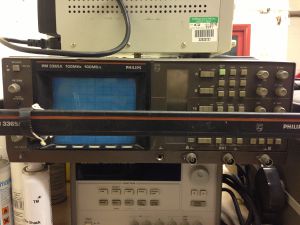Difference between revisions of "Equipment/PM3365A"
Jump to navigation
Jump to search
m (Add picture etc.) |
|||
| (6 intermediate revisions by 3 users not shown) | |||
| Line 1: | Line 1: | ||
| − | The PM3365A is an early digital scope, essentially an analog scope with a digital capture/storage unit - so the sampling is rather slow and digital features are not as fancy as today's designs. It also uses | + | {{EquipmentInfobox |
| + | |name=PM3365A Oscilloscope <!-- Name of the item. --> | ||
| + | |image=Pm3365a.jpg <!-- Image of the item. Leave with placeholder image if none exists. --> | ||
| + | |model=Philips PM3365A<!-- Model --> | ||
| + | |category=Equipment <!-- Main category. Please leave alone to keep item in this category --> | ||
| + | |subcat=Test equipment<!-- Sub-category if one exists. Please check main listing to see other categories contained within the main one --> | ||
| + | |status=<!-- Set to one of; Good working order, Faulty, Out of order, Under construction, Out of consumables, Scrapped, or Unknown --> | ||
| + | |consumables=Unknown <!-- Any items used up in normal operation, such as; ink, paper, saw-blades, cutting disks, oil, etc.. --> | ||
| + | |accessories=Unknown <!-- Any items associated with the equipment but not consumable, such as; drill bits, safety gloves, goggles, etc.. --> | ||
| + | |reqtraining=no | ||
| + | |trainlink=Unknown <!-- If training is required, provide a link to training signup or contact page. Otherwise leave blank. --> | ||
| + | |acnode=no | ||
| + | |owner=Unknown <!-- Provide a link to owners members page if other than LHS --> | ||
| + | |origin=Unknown <!-- If via pledge, please link to the completed pledge page on the wiki --> | ||
| + | |location=Ground floor, general circulation area, on the electronics workbench<!-- Floor, room/zone and location within that area --> | ||
| + | |maintainers=<!-- NO LINKS PLEASE; it currently breaks the template. If someone is nominated as managing the upkeep of this item, please list them here. --> | ||
| + | |template_ver=1.1 <!-- Please do not change. Used for tracking out-of-date templates --> | ||
| + | }} | ||
| + | The PM3365A is an early digital scope, essentially an analog scope with a digital capture/storage unit - so the sampling is rather slow and digital features are not as fancy as today's designs. It also uses LCD 'dials' for most of the standard knobs, making it a bit unintuitive for someone used to a traditional analog scope (and hard to read the settings, as the LCDs are not lit). | ||
| − | Analog bandwidth is 100MHz, but sampling speed is | + | Analog bandwidth is 100MHz, but sampling speed is only 100M s/s giving a useful one-shot bandwidth of only about 10 - 20MHz. |
| − | Some hints for use may be found in the [[Media:PM3365ref.pdf|Reference manual]] (pdf) - a peculiar halfway stage between user and service manual, or the [http://78.241.224.21/Schema/oscillo/PM3365/pm3365.pdf Service manual]. | + | Some hints for use may be found in the [[Media:PM3365ref.pdf|Reference manual]] (pdf) - a peculiar halfway stage between user and service manual, or the [http://78.241.224.21/Schema/oscillo/PM3365/pm3365.pdf Service manual]. I haven't found an online copy of the user manual yet. |
Latest revision as of 21:16, 4 June 2013
The PM3365A is an early digital scope, essentially an analog scope with a digital capture/storage unit - so the sampling is rather slow and digital features are not as fancy as today's designs. It also uses LCD 'dials' for most of the standard knobs, making it a bit unintuitive for someone used to a traditional analog scope (and hard to read the settings, as the LCDs are not lit).
Analog bandwidth is 100MHz, but sampling speed is only 100M s/s giving a useful one-shot bandwidth of only about 10 - 20MHz.
Some hints for use may be found in the Reference manual (pdf) - a peculiar halfway stage between user and service manual, or the Service manual. I haven't found an online copy of the user manual yet.
